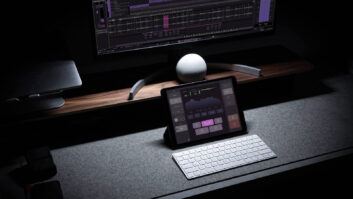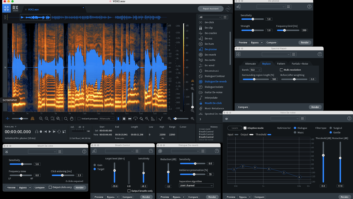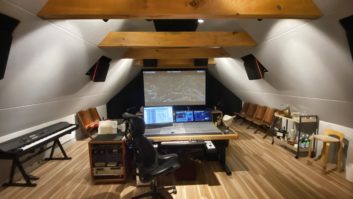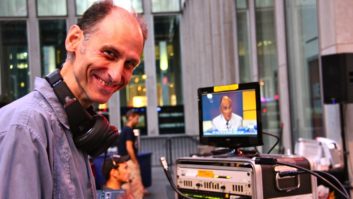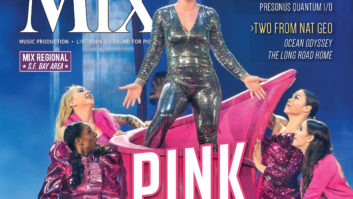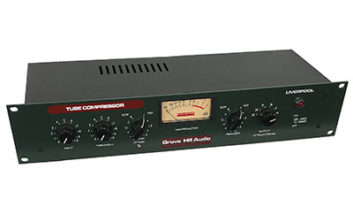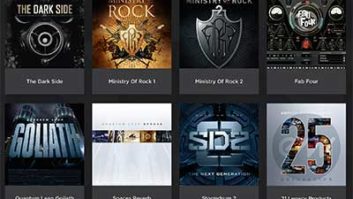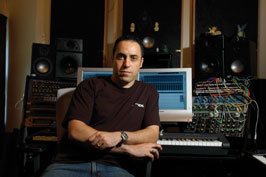

West Norwalk, Conn., is a quiet town located less than an hour from New York City. This time of year, a foot of snow covers the barren foliage and the streets lined with Colonial- and Cape Cod — style homes. In one of these homes, if you walk through the garage and up a stairway, you’ll find composer/producer Tom Salta. Neighbors in this picturesque town may not know it, but behind closed doors Salta composes electronic and orchestral music for some of the videogame industry’s most highly charged releases.
Tom Salta enjoys a control surface–free studio environment.
His recent scores include the MTV Video Music Award — nominated game Tom Clancy’s Ghost Recon: Advanced Warfighter and the IGN Award — winning Red Steel (both from Ubisoft). Beginning in the early ’90s, Salta spent most of his time recording album projects for a wide variety of major-label pop, rock, R&B, jazz and dance artists. In 2003, he shifted his career toward the game industry with a segue into film trailers. He also produced a solo album under the name Atlas Plug.
Today, Salta does most of his composing, recording and mixing in his project studio, Persist Music, which he’s operated in its current location since 2005. “When we were house shopping, one of the key factors was to have a space for the studio,” says Salta. “This house was perfect because it featured a fully finished great room over an attached garage, with a full bath and windows on both sides of the room overlooking all the trees that surround our property.”
Dave Mawhinney, who works for Sound Ideas, a high-end home theater and custom A/V systems company in Armonk, N.Y., assisted in the facility’s design, while another close friend of Salta’s, Bill Dougherty, handled the construction.
“The room has a 13-foot A-frame ceiling, so building slightly angled walls within the room took some serious geometry to get right,” says Salta. “Bill built all the framing for the walls on the floor first and then raised them up so they friction-fit on the existing ceiling. The angles were crazy. Even the front wall in the control room leans toward you a little bit to avoid any right angles. I teased Bill, and told him, ‘Thank God you were an engineering major!’”
The front of the control room is lined with custom rectangular wood-framed absorption panels that are made with 2-inch-thick black acoustical fabric, while the back wall is reflective with diffusion. An iso booth features doubled walls, ceiling and doors, and resides next to an office area. The booth offers sight lines to Salta’s chair through two sets of double-paned windows. “Because the ceilings are so high in the main room,” Salta adds, “we decided to give the interior of the booth a 7-foot ceiling and use that remaining height for storage above the booth.”
Inside the control room, Salta runs Apple Logic Pro 8 on a dual quad-core Mac Pro G5 using a Wacom tablet and pen. “I’ve always toyed with the idea of a control surface, but it’s simply not worth the extra real estate for me,” he says. Salta discovered the Wacom tablet when years of mouse-clicking left him with stiff wrists. “With the Wacom, you can literally jump from one corner to the next instantly; you don’t have to slide over. It’s a completely different way of working, but once you get it, it’s incredible. And I no longer have any stiffness.”
Salta keeps his outboard gear to a minimum, save for a few integral pieces, such as an API 512C mic preamp, an Apogee Rosetta 800 interface and an Apogee Big Ben master word clock. He also owns a custom tube mic designed by Roy Hendrickson, chief engineer at Avatar Studios in New York City. “It sounds like a [Neumann] U67, only with more low-frequency extension,” says Salta.
Although Salta incorporates live instruments as often as possible, he also calls upon extensive inventory of virtual instruments, including Spectrasonics’ Stylus RMX, Atmosphere and Trilogy. “I’ve always been a big fan of [Spectraonics founder] Eric Persing’s sounds, even those from the Roland days,” he says. Other key players include Native Instruments Kontakt and Absynth. “I really like the plug-ins that have built-in libraries with searchable attributes like the NI software,” says Salta. “That’s one of my favorite aspects of using VI’s like Absynth 4, FM8 and Massive.” He also uses the Project SAM sound libraries for more cinematic scores, as well as various custom libraries, depending on the project.
As Salta’s career progressed, his studio evolved to become more efficient and virtual. “Composing for games is about collaborating with game developers,” says Salta. “My love of games, combined with my past experience [in] scoring, programming, producing and songwriting, helps me anticipate the needs of the developers and create music that fully immerses the player in the experience.”
Heather Johnson is a Mix contributing editor.

LISTEN:
Main Theme From Tom Clancy’s Ghost Recon: Advanced Warfighter 2
LISTEN:
Gears and Guns From Full Auto 2: Battlelines
LISTEN:
Horror at Sea From Cold Fear
